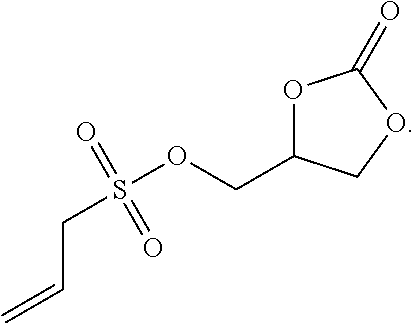Non-aqueous electrolyte lithium secondary battery
a lithium secondary battery, non-aqueous electrolyte technology, applied in the direction of non-aqueous electrolyte cells, cell components, electrochemical generators, etc., can solve the problems of lithium secondary batteries containing a large amount of ethylene carbonate, slow down of sei film, and more serious problems in lithium secondary batteries, etc., to achieve excellent charging/discharging characteristics, improve life cycle and low-temperature discharging characteristics, and restrain reaction effects
- Summary
- Abstract
- Description
- Claims
- Application Information
AI Technical Summary
Benefits of technology
Problems solved by technology
Method used
Image
Examples
embodiment 1
[0043]LiPF6 was added to a mixed organic solvent in which ethylene carbonate (EC) and ethyl propionate (EP) are mixed in a volume ratio of 3:7 to make 1M LiPF6 solution, and then 4-vinyl-1,3-dioxolane-2-one (VEC), a kind of cyclic carbonate having a vinyl group, was added as an anode decomposition inhibitor thereto at a content of 2 weight % based on the total weight of a non-aqueous electrolyte, thereby making a non-aqueous electrolyte.
embodiment 2
[0044]A non-aqueous electrolyte was made in the same way as in the Embodiment 1, except that 1,3-dioxolane-2-onylmethyl allyl sulfonate (VSEC) expressed by the following chemical formula was added instead of VEC.
embodiment 3
[0045]A non-aqueous electrolyte was made in the same way as in the Embodiment 1, except that 3-fluoroethylene carbonate (FEC), a kind of fluorinated ethylene carbonate, was added instead of VEC.
PUM
 Login to View More
Login to View More Abstract
Description
Claims
Application Information
 Login to View More
Login to View More - R&D
- Intellectual Property
- Life Sciences
- Materials
- Tech Scout
- Unparalleled Data Quality
- Higher Quality Content
- 60% Fewer Hallucinations
Browse by: Latest US Patents, China's latest patents, Technical Efficacy Thesaurus, Application Domain, Technology Topic, Popular Technical Reports.
© 2025 PatSnap. All rights reserved.Legal|Privacy policy|Modern Slavery Act Transparency Statement|Sitemap|About US| Contact US: help@patsnap.com



